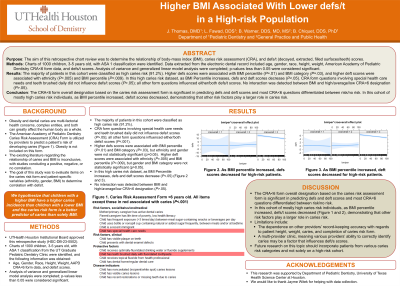Caries
146 - Higher BMI Associated With Lower defs/t in a High-risk Population


Jubin Thomas, DMD
PGY-2 Pediatric Dental Resident
University of Texas Health Science Center-Houston
The University of Texas Health Science Center at Houston
Houston, Texas, United States- BC
Brett t. Chiquet, D.D.S., Ph.D.
UT Pediatric Dentistry
- LF
Lubna Fawad, D.D.S.
UT Pediatric Dentistry
- BW
Ben f. Warner, D.D.S., M.D., M.S.
UT General Practice

Brett T. Chiquet, DDS, PhD
Associate Professor
University of Texas Health Science Center-Houston
University of Texas School of Dentistry
Houston, Texas, United States- BA
Bhavini Acharya, BDS, MPH
Associate Professor; Program Director, Pediatric Dentistry Residency
University of Texas Health Science Center-Houston
Houston, Texas, United States
Presenting Author(s)
Co-Author(s)
Research Mentor(s)
Program Director(s)
Purpose: The aim of this retrospective chart review was to determine the relationship of body-mass index (BMI), caries risk assessment (CRA), and defs/t (decayed, extracted, filled surfaces/teeth) scores.
Methods: Charts of 1000 children, 3-5 years old, with ASA 1 classification were identified. Data extracted from the electronic dental record included age, gender, race, height, weight, American Academy of Pediatric Dentistry CRA < 6 form data, and defs/t scores. Analysis of variance and generalized linear model analysis were completed; p-values less than 0.05 were considered significant.
Results: The majority of patients in this cohort were classified as high caries risk (91.2%). Higher defs scores were associated with BMI percentile (P=.01) and BMI category (P=.03), and higher deft scores were associated with ethnicity (P=.005) and BMI percentile (P=.009). In this high caries risk dataset, as BMI Percentile increases, defs and deft scores decrease (P < .05). CRA form questions involving special health care needs and teeth brushed daily did not influence defs/t scores (P>.05); all other form questions influenced either/both defs/t scores. No interaction was detected between BMI and high/average/low CRA < 6 designation (P>.05).
Conclusion: The CRA < 6 form overall designation is significant in predicting defs and deft scores and most CRA < 6 questions differentiated between risk/no risk. In this cohort of mostly high caries risk individuals, as BMI percentile increased, defs/t scores decreased, demonstrating that other risk factors play a larger role in caries risk.
Identify Supporting Agency and Grant Number:

.jpg)